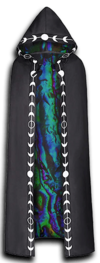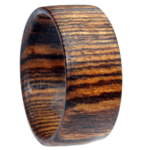Relics & Curiosities: Difference between revisions
Jump to navigation Jump to searchNo edit summary |
|||
| Line 17: | Line 17: | ||
= '''KNOWN ARTIFACTS''' = | = '''KNOWN ARTIFACTS''' = | ||
<br> | |||
<div class="mw-collapsible mw-collapsed" style="width:568px;"> | |||
<div style="font-weight:bold;line-height:1.6;">Adder Stone Ring</div> | |||
<div class="mw-collapsible-content toccolours"> | |||
''Adder stones are unusual glassy stones with a hole in their center. They wash up in Germany, Britain, and Egypt, where they’re called many different names: witch stones, hen gods, and aggri. In folklore, they were made from petrified serpent saliva and supposedly allowed users to turn invisible or see invisible beings. And indeed, Kindred proficient in Obfuscate seem even more so when they wear an adder stone ring. Of course, like everything, their gift comes with a cost: the wearer sometimes seems less visible, almost pale or faded out, when not using their Discipline. One Banu Haqim scholar connects the adder stone not with the saliva of serpents, but with the saliva of an unknown Antediluvian, which wipes the world’s memory of the wearer much as Kindred saliva wipes the memory of the vampiric bite.'' | |||
<br><br> | |||
'''System:''' Wearing the ring transforms one failure into a success when rolling an Obfuscate pool. Difficulty increases by 1 each time the wearer is successfully attacked. For every transformed failure or increased Difficulty for an attacker, the wearer loses one die from their next Social pool. | |||
<div style='text-align: right;'> | |||
''<sub>Blood Sigils, pg 137</sub>'' | |||
</div></div></div> | |||
<br> | |||
<div class="mw-collapsible mw-collapsed" style="width:568px;"> | |||
<div style="font-weight:bold;line-height:1.6;">Blade of Pelops</div> | |||
<div class="mw-collapsible-content toccolours"> | |||
''The Blade of Pelops first surfaced in the surviving record of a series of rituals carried out on an Aegean island in the Byzantine Empire in the 9th century. It was already very much an antique by then. The text notes the unusual colors in the polished stone of the blade: a swirl of rusty red amid the patinated white of old marble. In fact, the blade is not carved from rock at all, but a piece of an enormous fossilized shoulder bone, cut into the single-edged shape of a kopis knife. Maybe it’s ancient time literally being frozen inside its blade that gives the Blade of Pelops its remarkable effect.'' | |||
<br><br> | |||
'''System:''' A sorcerer who cuts themselves with the Blade at the beginning of a ritual (usually to draw the Blood needed for the working) increases their Blood Potency by two for the performance of the ritual. This either adds a die to the ritual pool, or lets them re-roll the ritual’s Rouse Check, depending (Corebook, pg. 216). | |||
<div style='text-align: right;'> | |||
''<sub>Blood Sigils, pg 138</sub>'' | |||
</div></div></div> | |||
<br> | <br> | ||
| Line 33: | Line 63: | ||
<div style='text-align: right;'> | <div style='text-align: right;'> | ||
''<sub>Chicago Folios, pg 166</sub>'' | ''<sub>Chicago Folios, pg 166</sub>'' | ||
</div></div></div> | |||
<br> | |||
<div class="mw-collapsible mw-collapsed" style="width:568px;"> | |||
<div style="font-weight:bold;line-height:1.6;">Humor Cups</div> | |||
<div class="mw-collapsible-content toccolours"> | |||
''The humor cups all look fairly innocuous simple stoneware cups— probably early Chinese pottery — each about an inch and a half in diameter. But the trained eye notices the shadow of unusual paint and burn marks underneath the cups’ dark greenish glaze. Drinking blood from them reveals their remarkable power: each cup transforms the Resonant humor of blood poured into it to another. One changes all blood poured inside it to choleric, another transforms its contents to be entirely sanguine. The blood only remains transformed as long as it’s in the cup, or if it’s been drunk. There are believed to be five of these cups in existence scattered around the globe; all that remains of a full set of twelve.'' | |||
<div style='text-align: right;'> | |||
''<sub>Blood Sigils, pg 137</sub>'' | |||
</div></div></div> | |||
<br> | |||
<div class="mw-collapsible mw-collapsed" style="width:568px;"> | |||
<div style="font-weight:bold;line-height:1.6;">Corpse-Wax Candles</div> | |||
<div class="mw-collapsible-content toccolours"> | |||
''Made from rendered human fat or the adipocere that sometimes forms on buried corpses, corpse-wax candles are a grim tool to harness the energy of the grave. Making them is a long, smelly, and unpleasant process. Liquid vitae is added to the fat as the candles are poured into their molds. When they burn, the acrid smoke and wavering light surrounding the ritual are infused with pure vitae.'' | |||
<br><br> | |||
'''System:''' Making the candles takes at least four hours and uses Intelligence + Craft; the Difficulty equals the number of candles the vampire is making at once out of a single corpse. If they fail, they cannot simply melt the wax down and try again with the same materials; they have been spoiled by the process and cannot be reused. If successfully made and deployed in a ritual, they transform one failed die on the Ritual roll, or any associated roll into a success. Each candle only works in one ritual, after which it’s nothing but a gross (and probably criminally evidentiary) piece of décor. | |||
<br><br> | |||
The good news is, a single human body contains a lot of fat: a sorcerer can get one candle per kilogram of body mass out of most fresh First World corpses, or one candle per 5 kg of pre-burial body weight out of corpses buried over a year ago, assuming they haven’t completely skeletonized yet. | |||
<div style='text-align: right;'> | |||
''<sub>Blood Sigils, pg 139</sub>'' | |||
</div></div></div> | |||
<br> | |||
<div class="mw-collapsible mw-collapsed" style="width:568px;"> | |||
<div style="font-weight:bold;line-height:1.6;">Hand of Glory</div> | |||
<div class="mw-collapsible-content toccolours"> | |||
''The murdering hand of a hanged man is hard to come by these days. If a sorcerer can find one — a real one — and they have a corpse-wax candle made from the body of the same man, they’ve got all the components of a Hand of Glory. Simply wrap the wrist in a cloth, fix the corpse-wax candle between its fingers, and light it. Those touched by the Hand of Glory’s glow drop into deep sleep (or torpor for Kindred), awakening only after being struck, or once the candle’s light goes out. If they were already asleep, they sleep as long as they normally would, and while the light burns, can only be awakened by being struck. The flame is weak — moving the Hand requires a Dexterity + Stealth roll to avoid it guttering out; it can be carried two meters per success before needing to stop or to re-roll. Someone holding the Hand cannot fight or move rapidly.'' | |||
<br><br> | |||
'''System:''' Lighting a Hand of Glory requires a Resolve + Blood Sorcery (or Occult) roll (Difficulty 4). While the Hand burns, everyone visible in its light must make a Composure + Resolve test (Difficulty 4) to resist its soporific effects, except the one who lit it. Vampires and other supernatural creatures can spend a point of Willpower to stave off the effects for a turn, if they fail the test. | |||
<br><br> | |||
'''Duration:''' The effect ends when the candle is extinguished, or when the candle burns out (after one hour). | |||
<div style='text-align: right;'> | |||
''<sub>Blood Sigils, pg 139</sub>'' | |||
</div></div></div> | </div></div></div> | ||
| Line 49: | Line 125: | ||
<div style='text-align: right;'> | <div style='text-align: right;'> | ||
''<sub>Homebrew, pg. XX</sub>'' | ''<sub>Homebrew, pg. XX</sub>'' | ||
</div></div></div> | |||
<br> | |||
<div class="mw-collapsible mw-collapsed" style="width:568px;"> | |||
<div style="font-weight:bold;line-height:1.6;">Obsidian Mirror</div> | |||
<div class="mw-collapsible-content toccolours"> | |||
''The most famous obsidian mirror belonged to the Tudor philosopher and magician John Dee, who purchased it after it was taken — likely stolen — from an Aztec town in the 16th century. A single round piece of obsidian, polished to a mirror finish, they reflect not just what’s in front of them, but far-off cities, strange animals, and distant faces. Those with training in Auspex find their senses can stretch farther and broader when they gaze into the mirror’s depths, as if they’re looking through a window at the object they scry.'' | |||
<br><br> | |||
'''System:''' Before using an obsidian mirror, roll Intelligence + Occult against Difficulty 3 to attune your senses to the mirror. On a win, add one die to Auspex pools when using the mirror. This is especially useful for Premonition (Auspex 2) and Clairvoyance (Auspex 5), but the clever seer can figure out other ways to incorporate the mirror into Auspex power use. Obsidian mirrors cannot transmit sound. | |||
<div style='text-align: right;'> | |||
''<sub>Blood Sigils, pg 137</sub>'' | |||
</div></div></div> | </div></div></div> | ||
| Line 82: | Line 173: | ||
* Powder of Rigidity | * Powder of Rigidity | ||
* Tapestry of Blood | * Tapestry of Blood | ||
Revision as of 17:15, 8 October 2023
Artifacts are rare, often sought-after items with special powers. The older an item's lineage is the more potential energy it carries and the more effective it may be as ab implement for blood crafts.
System: Distinguishing an actual sorcerous artifact in the wild usually requires Intelligence + Occult against a Difficulty of 2 or higher if the maker intended to conceal its nature. Some such items radiate in spectra perceptible by Auspex.
An item in ritual use for three centuries — not just any 17th-century antique — makes one die in a Ritual or other magical pool as a success: if you have a seven-die pool, flip one of them to a 9 before you roll the other six dice.
- At 600 years of magical use, the item pins two dice as successes.
- At 1,200 years of use, it pins three dice.
- At 2,400 years of use, it pins four dice, and so on.
You can’t just use the item in every ritual, though: it either has to be required in the ritual's ingredients list, or otherwise specifically, magically connected to that ritual. If there’s any doubt in the Storyteller’s mind, it’s not suitable. Of course, items that old have lots of former owners who might haunt them, have cursed them, or even come looking for them...
KNOWN ARTIFACTS
- Ankaran Sarcophagus
- Bloodspot Dice
- Eye of Hazimel
- Lamp of Constantine
- Malady Pen
- Monocle of Clarity
- Powder of Rigidity
- Tapestry of Blood


